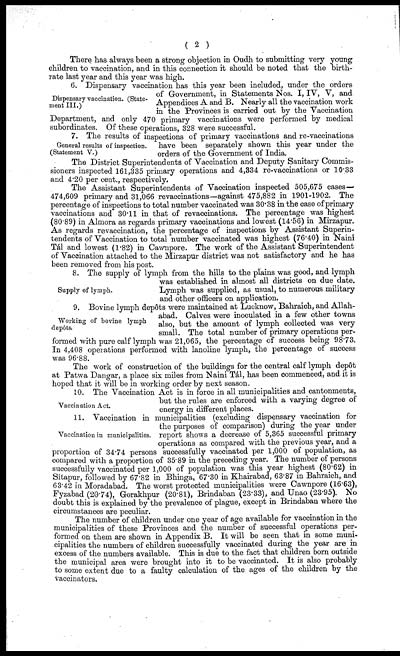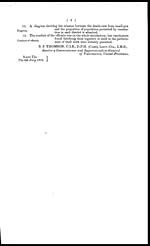Medicine - Vaccination > 1902-1928 - Report on vaccination in the United Provinces > Vaccination United Provinces of Agra and Oudh 1902-1913 > Notes on vaccination in the United Provinces for the year 1902-1903
(56) Page 2
Download files
Individual page:
Thumbnail gallery: Grid view | List view

( 2 )
There has always been a strong objection in Oudh to submitting very young
children to vaccination, and in this connection it should be noted that the birth-
rate last year and this year was high.
Dispensary vaccination. (State-
ment III.)
6. Dispensary vaccination has this year been included, under the orders
of Government, in Statements Nos. I, IV, V, and
Appendices A and B. Nearly all the vaccination work
in the Provinces is carried out by the Vaccination
Department, and only 470 primary vaccinations were performed by medical
subordinates. Of these operations, 328 were successful.
General results of inspection.
(Statement V.)
7. The results of inspections of primary vaccinations and re-vaccinations
have been separately shown this year under the
orders of the Government of India.
The District Superintendents of Vaccination and Deputy Sanitary Commis-
sioners inspected 161,335 primary operations and 4,334 re-vaccinations or 10.33
and 4.20 per cent., respectively.
The Assistant Superintendents of Vaccination inspected 505,675 cases—
474,609 primary and 31,066 revaccinations—against 475,882 in 1901-1902. The
percentage of inspections to total number vaccinated was 30.38 in the case of primary
vaccinations and 30.11 in that of revaccinations. The percentage was highest
(80.89) in Almora as regards primary vaccinations and lowest (14.56) in Mirzapur.
As regards revaccination, the percentage of inspections by Assistant Superin-
tendents of Vaccination to total number vaccinated was highest (76.40) in Naini
Tál and lowest (1.82) in Cawnpore. The work of the Assistant Superintendent
of Vaccination attached to the Mirzapur district was not satisfactory and he has
been removed from his post.
Supply of lymph.
8. The supply of lymph from the hills to the plains was good, and lymph
was established in almost all districts on due date.
Lymph was supplied, as usual, to numerous military
and other officers on application.
Working of bovine lymph
depots.
9. Bovine lymph depôts were maintained at Lucknow, Bahraich, and Allah-
abad. Calves were inoculated in a few other towns
also, but the amount of lymph collected was very
small. The total number of primary operations per-
formed with pure calf lymph was 21,065, the percentage of success being 98.73.
In 4,408 operations performed with lanoline lymph, the percentage of success
was 96.88.
The work of construction of the buildings for the central calf lymph depôt
at Patwa Dangar, a place six miles from Naini Tál, has been commenced, and it is
hoped that it will be in working order by next season.
Vaccination Act.
10. The Vaccination Act is in force in all municipalities and cantonments,
but the rules are enforced with a varying degree of
energy in different places.
Vaccination in municipalities.
11. Vaccination in municipalities (excluding dispensary vaccination for
the purposes of comparison) during the year under
report shows a decrease of 5,365 successful primary
operations as compared with the previous year, and a
proportion of 34.74 persons successfully vaccinated per 1,000 of population, as
compared with a proportion of 35.89 in the preceding year. The number of persons
successfully vaccinated per 1,000 of population was this year highest (80.62) in
Sítapur, followed by 67.82 in Bhinga, 67.30 in Khairabad, 63.87 in Bahraich, and
63.42 in Moradabad. The worst protected municipalities were Cawnpore (16.63),
Fyzabad (20.74), Gorakhpur (20.81), Brindaban (23.33), and Unao (23.95). No
doubt this is explained by the prevalence of plague, except in Brindaban where the
circumstances are peculiar.
The number of children under one year of age available for vaccination in the
municipalities of these Provinces and the number of successful operations per-
formed on them are shown in Appendix B. It will be seen that in some muni-
cipalities the numbers of children successfully vaccinated during the year are in
excess of the numbers available. This is due to the fact that children born outside
the municipal area were brought into it to be vaccinated. It is also probably
to some extent due to a faulty calculation of the ages of the children by the
vaccinators.
Set display mode to: Large image | Zoom image | Transcription
Images and transcriptions on this page, including medium image downloads, may be used under the Creative Commons Attribution 4.0 International Licence unless otherwise stated. ![]()
| Permanent URL | https://digital.nls.uk/87231075 |
|---|
| Attribution and copyright: |
|
|---|



![[Page 1]](https://deriv.nls.uk/dcn4/8723/87231074.4.jpg)
